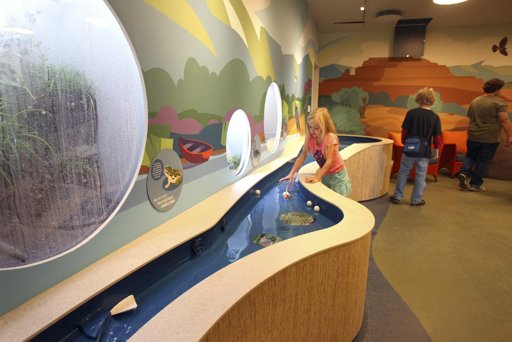Museum-goers are taking in the sounds, smell and feel of ancient life and landscapes at a new $100 million building in Salt Lake City.

People are even walking on top of exhibits, with glass-panel floors covering fossil dig sites. Over the years, they'll also be able to watch paleontologists separate fossils from rock in a glass-walled working laboratory.
The museum, which opened Nov. 18, is located in the Rio Tinto Center on the University of Utah campus. The center's copper and stone exterior is designed to blend into the high foothills of the Wasatch Range, and it's named for the mining company that donated the copper — 100,000 pounds of it — for the outside panels. The center was also designed to meet specifications for top ratings from the LEED (Leadership in Energy and Environmental Design) Green Building systems, with features like a planted roof and parking tiers that percolate rainwater. Rooftop solar panels will satisfy a quarter of the building's energy demands.
The best way to browse the 50,000 square feet of exhibit space is to spiral down from the top floor and backward in time, curators say. From the fifth level, which was turned over to Utah's five major Indian tribes, ramps descend into an 80-foot-deep lobby called The Canyon.
There are plenty of objects to touch, including a wall of human skulls — cast from the real thing — that demonstrate the passage of evolution. Other fossil casts with "Please Touch!" signs include a giant alligator in the main showroom that "ate dinosaurs for lunch," said Randy Irmis, the museum's curator of paleontology.
For children, the place is irresistible. They can get inside dig sites and turn over artifacts, turn on faucets to carve rivers in a table of sand, or aim fans to control the shape of sand dunes. They can also spend time exploring and experimenting in supervised science labs.
Visitors have used words like "breathtaking," ''cool" and "amazing" to describe their reactions.
Ralph Appelbaum, the exhibit designer who worked closely with Todd Schliemann of Ennead Architects on the museum, hoped it would turn out that way. "There's very little barrier between you and what's mounted," he said. "These galleries are really designed to be interactive."
This is a working museum as well, with a wing for scientific research and a climate-controlled repository for millions of natural objects and human artifacts.
"Isn't it cool? We're shell-shocked," said Duncan Metcalf, curator of archaeology, who gets a thrill walking into the building every morning. "It's an architectural marvel."
The museum has only a few choice window views, in order to keep daylight from aging sensitive artifacts and bones on display, but those views are strategic.
One overlooks the Great Salt Lake at an exhibit showing the basin filling and emptying over time with climate change. Another view frames the spine of the 11,000-foot Wasatch mountains.
The museum was built with a combination of public and private funding. The state of Utah gave $25 million and the federal government $16.5 million. Salt Lake County taxpayers borrowed $15 million, and donors put up more than $44 million. That includes the donation of copper that Rio Tinto dug up at the Kennecott mine across the Salt Lake valley.
Pete Ashdown, a Utah Internet businessman who donated over $50,000 to the museum, spent much of his youth at the university's former museum — a creaky, dusty old building with old-school lifeless exhibits where his mother helped run educational programs as a volunteer. He said he "jumped at the opportunity" to support the new digs.
"I've been to the Smithsonian and New York's natural history museum, and this is unique. Our museum is in the setting," said Ashdown. "What you see was drawn out of Utah itself."
Author: Paul Foy | Associated Press [November 29, 2011]